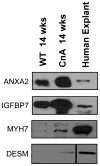Pilot study identifying myosin heavy chain 7, desmin, insulin-like growth factor 7, and annexin A2 as circulating biomarkers of human heart failure
- PMID: 23713052
- PMCID: PMC3735469
- DOI: 10.1002/pmic.201200455
Pilot study identifying myosin heavy chain 7, desmin, insulin-like growth factor 7, and annexin A2 as circulating biomarkers of human heart failure
Abstract
In-depth proteomic analyses offer a systematic way to investigate protein alterations in disease and, as such, can be a powerful tool for the identification of novel biomarkers. Here, we analyzed proteomic data from a transgenic mouse model with cardiac-specific overexpression of activated calcineurin (CnA), which results in severe cardiac hypertrophy. We applied statistically filtering and false discovery rate correction methods to identify 52 proteins that were significantly different in the CnA hearts compared to controls. Subsequent informatic analysis consisted of comparison of these 52 CnA proteins to another proteomic dataset of heart failure, three available independent microarray datasets, and correlation of their expression with the human plasma and urine proteome. Following this filtering strategy, four proteins passed these selection criteria, including myosin heavy chain 7, insulin-like growth factor-binding protein 7, annexin A2, and desmin. We assessed expression levels of these proteins in mouse plasma by immunoblotting, and observed significantly different levels of expression between healthy and failing mice for all four proteins. We verified antibody cross-reactivity by examining human cardiac explant tissue by immunoblotting. Finally, we assessed protein levels in plasma samples obtained from four unaffected and four heart failure patients and demonstrated that all four proteins increased between twofold and 150-fold in heart failure. We conclude that MYH7, IGFBP7, ANXA2, and DESM are all excellent candidate plasma biomarkers of heart failure in mouse and human.
Keywords: Animal proteomics; Bioinformatics; Plasma; Secreted protein.
© 2013 WILEY-VCH Verlag GmbH & Co. KGaA, Weinheim.
Conflict of interest statement
Conflict of interest. Drs Liu and Gramolini hold a patent entitled “Use of IGFBP-7 in the assessment of heart failture”
Figures






Similar articles
-
Changes in Cx43 and NaV1.5 expression precede the occurrence of substantial fibrosis in calcineurin-induced murine cardiac hypertrophy.PLoS One. 2014 Jan 31;9(1):e87226. doi: 10.1371/journal.pone.0087226. eCollection 2014. PLoS One. 2014. PMID: 24498049 Free PMC article.
-
Constitutively active calcineurin induces cardiac endoplasmic reticulum stress and protects against apoptosis that is mediated by alpha-crystallin-B.Proc Natl Acad Sci U S A. 2010 Oct 26;107(43):18481-6. doi: 10.1073/pnas.1013555107. Epub 2010 Oct 11. Proc Natl Acad Sci U S A. 2010. PMID: 20937869 Free PMC article.
-
TRPC6 fulfills a calcineurin signaling circuit during pathologic cardiac remodeling.J Clin Invest. 2006 Dec;116(12):3114-26. doi: 10.1172/JCI27702. Epub 2006 Nov 9. J Clin Invest. 2006. PMID: 17099778 Free PMC article.
-
Folic acid supplementation and malaria susceptibility and severity among people taking antifolate antimalarial drugs in endemic areas.Cochrane Database Syst Rev. 2022 Feb 1;2(2022):CD014217. doi: 10.1002/14651858.CD014217. Cochrane Database Syst Rev. 2022. PMID: 36321557 Free PMC article.
-
Calcineurin: a poorly understood regulator of muscle mass.Int J Biochem Cell Biol. 2013 Oct;45(10):2173-8. doi: 10.1016/j.biocel.2013.06.029. Epub 2013 Jul 6. Int J Biochem Cell Biol. 2013. PMID: 23838168 Free PMC article. Review.
Cited by
-
Emerging biomarkers in heart failure and cardiac cachexia.Int J Mol Sci. 2014 Dec 22;15(12):23878-96. doi: 10.3390/ijms151223878. Int J Mol Sci. 2014. PMID: 25535078 Free PMC article. Review.
-
Biomarkers in Acute Heart Failure Syndromes: An Update.Curr Cardiol Rev. 2022;18(3):e090921196330. doi: 10.2174/1573403X17666210909170415. Curr Cardiol Rev. 2022. PMID: 34503430 Free PMC article. Review.
-
Transmural heterogeneity of cellular level power output is reduced in human heart failure.J Mol Cell Cardiol. 2014 Jul;72:1-8. doi: 10.1016/j.yjmcc.2014.02.008. Epub 2014 Feb 20. J Mol Cell Cardiol. 2014. PMID: 24560668 Free PMC article.
-
Insulin-like growth factor binding protein 7 (IGFBP7), a link between heart failure and senescence.ESC Heart Fail. 2022 Dec;9(6):4167-4176. doi: 10.1002/ehf2.14120. Epub 2022 Sep 11. ESC Heart Fail. 2022. PMID: 36088651 Free PMC article.
-
Measurement of novel biomarkers to predict chronic heart failure outcomes and left ventricular remodeling.J Cardiovasc Transl Res. 2014 Mar;7(2):250-61. doi: 10.1007/s12265-013-9522-8. Epub 2013 Dec 6. J Cardiovasc Transl Res. 2014. PMID: 24309956
References
-
- Jong P, Gong Y, Liu PP, Austin PC, Lee DS, Tu JV. Care and outcomes of patients newly hospitalized for heart failure in the community treated by cardiologists compared with other specialists. Circulation. 2003;108:184–191. - PubMed
-
- Jong P, Vowinckel E, Liu PP, Gong Y, Tu JV. Prognosis and determinants of survival in patients newly hospitalized for heart failure: a population-based study. Arch Intern Med. 2002;162:1689–1694. - PubMed
-
- Lee DS, Mamdani MM, Austin PC, Gong Y, Liu PP, Rouleau JL, Tu JV. Trends in heart failure outcomes and pharmacotherapy: 1992 to 2000. Am J Med. 2004;116:581–589. - PubMed
Publication types
MeSH terms
Substances
Grants and funding
LinkOut - more resources
Full Text Sources
Other Literature Sources
Medical
Miscellaneous

